Matthew Millado Perth
Matt Millado | Perth, Australia | Fall 2019
August
Part 1: Chaos
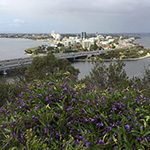
Well my first month in Australia was a blur! I arrived here in Perth on Friday, July 26th after an unfortunate series of flight delays turned my 24-hour trip into a 48-hour trip. Further adding to the chaos is the fact that I arrived one week later than everyone else, missed orientation because I was finishing up my summer internship, and was thrown into my first week of classes just three days after I arrived. I didn’t have my schedule straightened out at all before I left either, and ended up changing three of my five classes by the end of the week. So my Australian began, with me jet-lagged, all sorts of confused and incredibly excited for the coming semester.
My name’s Matt Millado, and I’m a junior studying Environmental Sciences. I’m here in Perth with seven other wonderful Notre Dame students (see third pic). I wanted to come to Perth because it’s a relatively large city, which is very different from the rural town I grew up in, and it also has a strong sense of outdoor culture and access to a bunch of state and national parks. I’m attending the University of Western Australia (UWA) and live at a residential college right across the road from campus. UWA’s campus is beautiful – there are tropical plants everywhere and you can walk from one end to the other in about 20 minutes. It’s also right on the coast of the beautiful Swan River – we saw dolphins swimming around during our first week!
Part 2: The harsh Australian winter
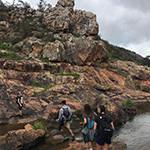
It’s winter here and boy is it tough. Temperatures range from 60-80º F and we’ve gone to the beach at least once a week. Thanks to Perth’s convenient public transportation system we can get to Cottesloe beach to sunbathe or downtown Perth to shop in just 15 minutes. We’ve also gone on some awesome hikes. Our first hike was at Banyowla Regional Park. Here we saw a waterfall, wild kangaroos and some cool Australian flora. Eventually we got lost and ended up climbing some minor cliffs and crawling through some bushes to find our way back to the main trail. We left with scratched up legs but things like that just make the experience more memorable. Our second hike was at Serpentine National Park where we saw more waterfalls, wandered along a peaceful stream and hiked up a bluff to get some sweet views of the forest. We also befriended a farmer while we were waiting for the park to open and he gave us a bag of freshly-picked clementines from his trees before we left. Super random, super cool. Australian hospitality is definitely a thing and I’m all for it.
Part 3: Social life
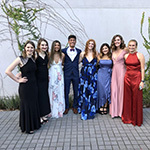
Speaking of Australian hospitality, all the Australians I’ve met are so friendly. I live in a residential college called St. Thomas More, or Tommy for short. I was nervous about missing orientation but I felt welcomed as soon as I got here. People introduced themselves to me right when I sat down at the dining hall for my first meal and it’s been fun getting to know everyone since then. There’s a fair amount of international students here at Tommy too, which is interesting. I’d say it’s split 50/50 between Australian students and international students. I think that’s one of the reasons why everyone is so friendly. I’ve met some cool Australians and other exchangers from the U.S., London and India, to name a few.
Tommy puts on a lot of social events to keep us entertained and build community. In a nutshell, students at Tommy love to drink, dance and dress fancy. Some of the events they’ve put on for us include: a Christmas in July formal dinner, a wedding-themed bar crawl, and the highly-anticipated Tommy Ball that was held at the Aquarium of Western Australia this year. It was certainly an unforgettable experience. I’m guessing Notre Dame would prefer I don’t talk at length about drinking abroad, but I will say it’s interesting how the drinking age of 18 affects college social life. On that note, I bid you farewell until next month!
Matt’s ecological thought of the month: Why are so many Australian mammals adapted to hop instead of run?
Australian slang of the month: Pips (= seeds in fruit)
September
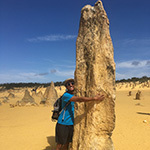
September was full of amazing adventures and unforgettable memories. One weekend we took a day trip a few hours north to visit the Pinnacles Desert in Nambung National Park and the Lancelin Sand Dunes. The Pinnacles are these interesting limestone formations that pop up out of nowhere after a short walk through some bushland. They’re pillar-shaped, one to five metres tall, and formed 25,000 to 30,000 years ago from seashell deposits. After that we traveled back south to the Lancelin Sand Dunes where we rented boards and went sand boarding. It seemed cheesy to me at first and I was skeptical about how fast we would actually go, but it turned out to be super fun and the boards went pretty fast! The best part was definitely watching everyone fall and get covered in sand. We ended the day on a nearby beach where we swam in the waves, washed all of the sand off our bodies and stayed to watch the sun set. The wind and waves tossed a bunch of mist into the air and it honestly looked like a movie scene. Certainly a sight I’ll never forget.
The highlight of the month was definitely the road trip we took over the mid-semester study break. We traveled up the coast of Western Australia, making stops at Kalbarri, Exmouth and Karijini. Speed summary: nine mates, eight days, three tents, two cars, and over 40 hours of driving!
Our first stop was Kalbarri National Park, where we stayed for one night on our way up to Exmouth. Kalbarri is full of sandstone sea cliffs that look out over the Indian Ocean. It also contains the lower half of the Murchison River, which has cut a massive gorge in the rock over the years and created some really magnificent geological formations.

Next we went to Exmouth, a small beach town on the coast. Exmouth is all about snorkeling Ningaloo Reef. Ningaloo Reef is one of the longest fringing reefs (reefs that hug the shoreline) in the world so you can walk a few steps into the water and see tons of different corals and marine life! Both of our snorkeling sites were in Cape Range National Park. We visited Turquoise Bay and Oyster Stacks, the latter of which is so shallow that you can only snorkel during high tide. They were both so amazing that we went back to those same spots on our second day. We saw tons of colorful parrot fish, box fish, starfish and sea turtles, to name a few. We also spent hours sunbathing and tossing a football around on the beach, and at night we’d stargaze. We also hiked two gorges in the national park where we saw wild rock wallabies and rays swimming in one of the estuaries.
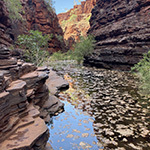
We spent the last three days of our trip in Karijini National Park. Karijini is a huge national park with tons of gorges and red dirt that stains everything you own. We hiked four gorges that each had unique rock faces and freshwater pools, streams and waterfalls. Some hikes we even had to take off our shoes (and sometimes bags) and wade or swim through the water to get to the end. Most days the temperature was over 100 °F so the cool water always felt amazing. We also hiked up Mt. Bruce, the second highest mountain in Western Australia, at 3:00 am and got to the top just in time to see the sunrise. I was exhausted by the end of it but the view was well worth it. In between hikes we swam a lot, cliff jumped where it was deep enough, and explored each area as much as we could. My favorite hike was Knox Gorge, which ended at a peaceful lagoon that had bats flying overhead and a resident python that was beautiful but slightly terrifying.
The landscapes of Australia continue to amaze me, and I am so grateful for this experience and all the people I get to share it with. Now if you’ll excuse me, I have a week’s worth of studying to catch up on.
Matt’s ecological thought of the month: A lot of the plants here are hard and poky – self-defense mechanism or dehydration (or both)?
Australian slang of the month: Ranga (= redhead)
October
I haven’t talked much about academics yet, but I swear I’m studying here too not just having fun. This semester I’m taking Conservation Biology, Environmental Economics, Plant Biology, Environmental Policy and Planning, and Hydrology. I love them all but I do wish Notre Dame didn’t make us enroll in 5 courses while we’re here. Anyways, classes here run a little differently than in the U.S. UWA requires that all lectures get recorded and posted online so attendance is really poor. For example, there are 60 students in my Conservation Biology class and only 10-12 of us regularly show up for lectures. Aside from attendance, the professors are great and everyone addresses them by their first name which is cool. Some of the assignments that I’ve done and enjoyed are a policy brief on green roofs in Australia, a paper on the economics of deforestation, and a research report on Grevillea, a threatened plant genus that is endemic to Australia. A lot of my classes are field-heavy too which is fun. For Conservation Biology we visited the Perth Zoo, Karakamia Wildlife Sanctuary, and Kings Park to see some of the conservation efforts they’re undertaking firsthand. For Hydrology we had an “Amazing Catchment Race” where they gave us UWA vehicles and we drove to different bodies of water around the city to collect a variety of data: flow measurements, nutrient concentrations, all that fun stuff. Our team didn’t win (I’m pretty sure we got last actually) but it was a good time.

Outside of class, Notre Dame has been organizing cultural excursions for us to places in and around Perth. We’re accompanied by an Anthropology professor and one of his master’s students, and they manage to fit a lot of information into our short trips. This month they took us to Margaret River, a region in the southwest corner of Western Australia that is known for its wineries and surfing culture. It’s also a globally recognized biodiversity hotspot. During our trip we did a wine tasting at Cullen’s Winery, volunteered with Margaret River Nature Conservation to remove invasive weeds, and took a surfing lesson at 8 am so we could get back in time for the intercollege Australian rules football (footy for short) grand finals. It was my first time watching footy and I loved it – our college took first for the girls and second for the guys. Footy is a really rough sport with lots of tackling, no pads, and a strong teamwork aspect.

My friends and I also visited Rottnest this month, a small island just off the coast of Perth. We spent a whole day biking around the island, making stops to take in the view and relax in the sand. Rottnest is famous for its large population of quokkas – which are little marsupials that always look like they’re smiling. They have no natural predators on the island so they’re very friendly and nonchalant around people. Aside from these little guys there are tons of white sand beaches, snakes, skinks, and even seals at one part of the island. Although Rottnest is beautiful there is controversy around turning it into a tourist destination because of its dark past, as it was once used as a prison for Aboriginal people.

October is our last full month in Perth so we’re getting very close to exams. We have a weeklong study break before finals, but we decided to use this free time to travel to Bali for a week. All the Notre Dame exchangers plus three other Americans from different universities went and we had a blast. We visited temples, ate street food, got robbed by monkeys, and enjoyed the nightlife. Every other UWA student we talked to about the trip said we were crazy for traveling the week before exams, and I kind of agree with them. I have no regrets though, and now that I’m back in Perth I’m ready to buckle in for finals. Wish me luck!
Ecological thought of the month: How did quokkas end up on Rottnest Island but none of their predators?
Australian slang of the month: Dingo ate my baby (used to mock someone who is lying)
November

November was mostly taken up by final exams and enjoying our last few days in Perth. The UWA exam period spanned the first two weeks of November, but thankfully most of us were finished by the start of the second week. Once we made it through exams we spent our time kayaking, going to the beach and taking in as much of the warm weather as we could before returning to winter back home. One of my favorite things we did was spend a day in Scarborough, a lively beach town just north of Perth. We lounged on the beach during the day, watching kite surfers skate across the water and periodically hopping in to cool off and bob with the waves. Around sunset a bunch of food vendors arrived for the summer night markets, setting up tents and trucks in the park that runs alongside the beach. I was surprised by the diversity of food options at the market: dishes from India, Brazil, Turkey, Japan and a suite of other countries were represented at the markets. I decided to try a Turkish gozleme at a tent where I could watch the family make the dough and cook everything it all in front of me. It was awesome to watch and even better to eat. My friends and I ate together, watched the sunset and admired more kite surfers until dark. At one point a pair of fire twirlers set up on the beach – watching them was a great end to the night.
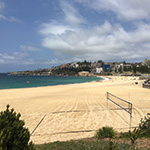
After many sad goodbyes to my friends at Tommy, I started to make my way home to Michigan. First, however, I stopped in Coogee (a small town just outside Sydney) for a few days to get my open water diving certification. Getting my dive certification has been on my bucket list for some time now, but I’ve always had this irrational fear of the ocean. Something about its vastness, not being able to see what’s underneath you without a pair of goggles, and all the things that can potentially kill you formed the basis of this fear. But, with the help of the Blue Planet series on Netflix, I reached a point where inspiration overcame fear and I couldn’t let my discomfort stop me from exploring this mysterious and exciting world. My dive course lasted three days where we reviewed dive theory, learned skills in a pool, then practiced those skills in four open water ocean dives. Our instructors took us to two calm spots that were perfect for learning and contained an exciting display of marine life. We saw jellyfish, an octopus, stingrays and all sorts of colorful fish. My favorite sight was a massive blue groper that was about 4 feet long and surprisingly friendly. My dive instructor picked up an urchin and offered it to the groper, which took it by its exposed underside and swam off to eat it. The ocean is truly an amazing place, and way different from any terrestrial environment I can think of. I loved the challenge and excitement of exploring it, and I can’t wait to dive more in the future.

I could not have asked for a better time in Australia. The people I met, places I visited and things I learned have really changed me for the better. The way I view the environment is enhanced after taking so many environmental classes that each offered their own take on the natural world. I feel more independent, more confident in what I do and how I interact with others, and inspired to continue exploring the world around me. Thanks for following along, and cheers to good friends, good times, and more adventures to come.
Ecological thought of the month: Even the kelp is spiky; there’s gotta be something going on here.
Australian slang of the month: Mozzie (= Mosquito)